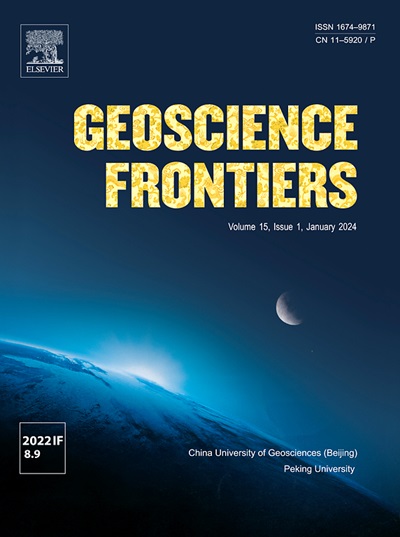Heavy Si isotope compositions of subduction zone fluids controlled by fluid-rock interaction and fluid evolution
IF 8.9
1区 地球科学
Q1 GEOSCIENCES, MULTIDISCIPLINARY
引用次数: 0
Abstract
Jadeitites are formed either through direct precipitation from Na-Al-Si rich fluids (P-type), or by replacement of magmatic protoliths (R-type) in subduction zones. They are valuable targets for investigating the mobility behavior and chemical composition of subduction zone fluids. The Rio San Juan Complex (RSJC) in the northern Dominican Republic hosts both P- and R-type jadeitites and jadeite-rich rocks, which provide ideal samples for addressing such issues. Here, we present trace element and Sr-Nd-O-Si isotope compositions of RSJC jadeitites and related rocks. Most samples show similar REE patterns, trace element distributions and δ18O values to those of plagiogranite protoliths, indicating the predominance of R-type origin in RSJC. The P-type samples exhibit slightly higher δ30Si values (−0.15‰ to 0.25‰) than that of R-type samples (−0.20‰ to 0.08‰), which place above the igneous array. The low (87Sr/86Sr)i (0.70346 to 0.70505) and high εNd(t) values (4.6 to 6.8) of the P-type jadeitites and quartzites, along with relatively low δ18O values (4.7‰ to 6.4‰) of their forming fluids, indicate that the fluids are likely derived from the altered basaltic crust rather than from oceanic sediment. However, the estimated jadeitite- and quartzite-forming fluids exhibit distinct δ30Si values (0.76‰ to 0.99‰ and –0.48‰ to –0.08‰, respectively), implying an evolution of the fluids that modified the Si isotopic compositions. Since fluid metasomatism and related desilication process could have lowered the whole-rock δ30Si values, the heavy Si isotope compositions of the R-type samples are produced from the external fluids. Combing Rayleigh distillation and binary mixing simulations, we propose that fluids derived from altered oceanic crust obtained high δ30Si values after crystallization of minerals enriched in light Si isotopes. The P-type jadeitites are formed through direct precipitation from this fluid. As the plagiogranite protoliths were continuously replaced by this fluid, the formed R-type samples (jadeitites and quartzites) also exhibit high δ30Si values. Such rocks could significantly alter the Si isotope compositions of local mantle when they are deeply subducted at convergent plate margins.

受流-岩相互作用和流体演化控制的俯冲带流体重硅同位素组成
硬玉岩要么是由富钠铝硅流体(p型)直接沉淀形成的,要么是由俯冲带岩浆原岩(r型)置换形成的。它们是研究俯冲带流体运移行为和化学成分的有价值的目标。多米尼加共和国北部的里约热内卢圣胡安杂岩(RSJC)拥有P型和r型翡翠岩和富含翡翠的岩石,为解决这类问题提供了理想的样本。本文研究了RSJC翡翠岩及其相关岩石的微量元素和Sr-Nd-O-Si同位素组成。大部分样品的REE模式、微量元素分布和δ18O值与斜花岗原岩相似,表明rs - jc以r型成因为主。p型样品的δ30Si值(- 0.15‰~ 0.25‰)略高于r型样品(- 0.20‰~ 0.08‰),均位于火成岩阵列之上。p型翡翠岩和石英岩的低(87Sr/86Sr)i值(0.70346 ~ 0.70505)和高εNd(t)值(4.6 ~ 6.8),其形成流体的δ18O值相对较低(4.7‰~ 6.4‰),表明其流体可能来源于蚀变玄武岩壳,而非海洋沉积。然而,形成硬玉岩和石英岩的流体δ30Si值明显(分别为0.76‰~ 0.99‰和- 0.48‰~ - 0.08‰),表明流体的演化改变了Si同位素组成。由于流体交代和相应的脱硅过程可能降低了整个岩石的δ30Si值,因此r型样品的重Si同位素组成来自外部流体。结合瑞利蒸馏和二元混合模拟,我们认为来自蚀变洋壳的流体在富含轻Si同位素的矿物结晶后获得了高δ30Si值。p型翡翠岩是由该流体直接沉淀形成的。由于斜花岗原岩不断被该流体取代,形成的r型样品(翡翠岩和石英岩)δ30Si值也较高。这些岩石在会聚板块边缘深俯冲时,会显著改变局部地幔的Si同位素组成。
本文章由计算机程序翻译,如有差异,请以英文原文为准。
求助全文
约1分钟内获得全文
求助全文
来源期刊

Geoscience frontiers
Earth and Planetary Sciences-General Earth and Planetary Sciences
CiteScore
17.80
自引率
3.40%
发文量
147
审稿时长
35 days
期刊介绍:
Geoscience Frontiers (GSF) is the Journal of China University of Geosciences (Beijing) and Peking University. It publishes peer-reviewed research articles and reviews in interdisciplinary fields of Earth and Planetary Sciences. GSF covers various research areas including petrology and geochemistry, lithospheric architecture and mantle dynamics, global tectonics, economic geology and fuel exploration, geophysics, stratigraphy and paleontology, environmental and engineering geology, astrogeology, and the nexus of resources-energy-emissions-climate under Sustainable Development Goals. The journal aims to bridge innovative, provocative, and challenging concepts and models in these fields, providing insights on correlations and evolution.
 求助内容:
求助内容: 应助结果提醒方式:
应助结果提醒方式:


